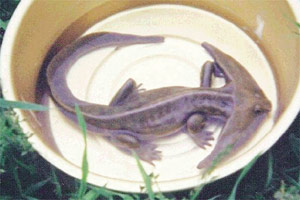Does this animal really exist?
Professor Patrick J. Schembri, Department of
Biology, University of Malta, Msida.
 |
|
The Diplocaulus |
Over the last two or three weeks, I have been sent the
accompanying picture at least nine times by different persons who
had received it over the Internet and who wanted more information
about the creature depicted.
A number of versions of this picture seem to be doing the rounds.
The most common has accompanying text that says that this creature
occurs at Il-Maghluq in Marsascala, while another version says that
this animal was photographed at Bahrija. I am invariably asked if
this is a real discovery or if it is a hoax, whether such an animal
actually exists, whether it is a salamander or a lizard, and whether
this is a native or an alien species.
The short answer to all these queries is that yes, this is a
hoax, but the animal shown really exists, or rather, it has existed,
since it became extinct about 270 million years ago.
The picture itself is a hoax that seems to have originated
overseas, although I have not been able to trace where. The image
might be of a model or it might be a doctored image created
digitally. The animal shown is a type of early amphibian called
Diplocaulus that is distinguished by two elongated bones at the back
of the skull that in life gave the animal a very odd,
boomerang-shaped head.
Diplocaulus lived some 270 million years ago, long before the
dinosaurs appeared, and its fossils have been found in North
America. Although not a salamander but rather a member of a now
extinct group of amphibians called nectridians, Diplocaulus very
much resembles a modern salamander apart for its head.
The very distinctive head may have been an adaptation against
predators, since the wide head would make Diplocaulus difficult to
swallow, or it may have aided the animal to swim by acting as a
hydrofoil. Like most other early amphibians, Diplocaulus lived in or
near water. It probably fed on insects or fish. It was also
considerably larger than the image doing the rounds suggests, since
fossils as large as 80 cm in length have been discovered.
Discovering a live Diplocaulus at Il-Maghluq would certainly be a
major scientific discovery rivalling the discovery of the
coelacanth. Unfortunately, this is science
fiction! |